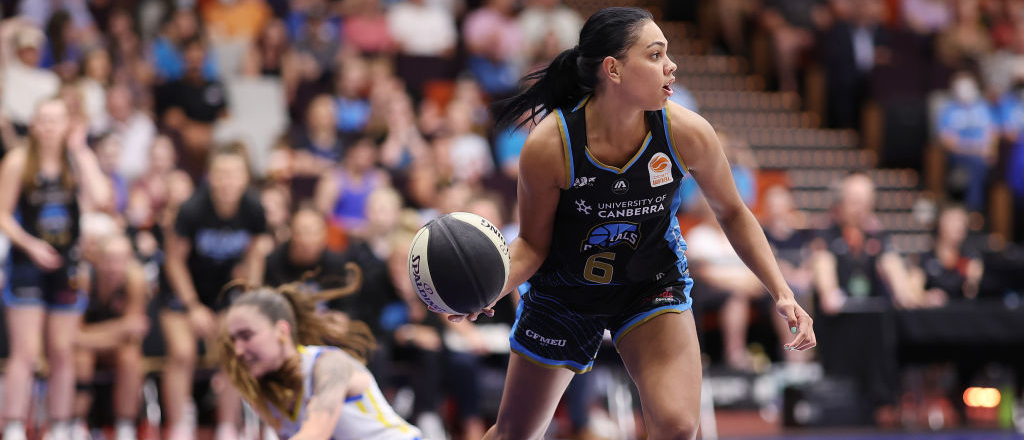With limited roster spots and the need to make an immediate impact to stick, meshing skillset and opportunity is essential for success as a young player entering the WNBA. That makes the Los Angeles Sparks drafting Shaneice Swain, a 19-year-old guard from Australia, with the second pick in the second round of the 2023 WNBA Draft all the more intriguing.
Swain, who currently plays for the University of Canberra Capitals of the Women’s National Basketball League, is a draft-and-stash player for the Sparks, someone who won’t be on the books and start her rookie contract until she officially comes to the United States and signs with the team whenever she’s ready. The Sparks have consistently said that everything is about building for a better future ever since wholesale front office and coaching changes. What that means is balancing decisions that help the team now with those that can most positively impact them long-term, something general manager Karen Bryant brought up while discussing Swain after the 2023 WNBA Draft on Monday.
“We don’t expect Shaneice to come over and play and be a part of the team in 2023,” Bryant said. “But, we’re excited about the future prospect of her coming over here. We’re obviously mindful of her age and want to be smart about how we continue to invest in her future and bring her over at the right time.”
Swain has been on the scouting radar for some time, playing internationally for Australia’s youth team and performing well for the Capitals during the most recent WNBL season. She most recently popped during the inaugural Nike Hoop Summit, showing out as one of the top prospects in Portland during the week of practice, scrimmages, and the USA vs. World game.
With a crafty handle, flashy playmaking ability, herky-jerky pacing, and a good touch inside and outside the arc, Swain has a great deal of promise as a ball screen heavy combo guard.
Draft-and-stashes aren’t uncommon in the W, but provide an extremely interesting inflection point in looking at the draft and scouting as a whole in women’s basketball. Per league rules, domestic draft entrants must have turned 22 during their draft year (whether it be before or after), while international entrants must have turned 20.
We’ve seen more players selected with draft-and-stash in mind in the top 16 of the draft over the last five years than the decade prior. Six international prospects have been drafted in the top 16 over the last three drafts, as many as there were from 2008-2018. Draft classes are certainly volatile, varying on a year by year basis, but the willingness to draft younger non-domestic talent seems to be a growing trend, as teams look beyond the college ranks to seek out some value.
Identifying talent earlier, while also acknowledging that they may not be ready to come play immediately, provides the opportunity to find a valuable prospect and watch them get better by being a professional at such a young age, while also preserving valuable roster and cap space in the present.
“Her youth and her upside are such an appeal,” says Sparks head coach Curt Miller. “Her best days are ahead of her, she won’t turn 20 until after the completion of the WNBA season.”
Part of the intrigue, says Miller, came in watching her perform in Portland against players that she would be going up against if she played college ball in the States to help gauge where she is now. Playing in a professional organization and competing against pros, a number of whom have WNBA experience, provides an environment to hone herself in a different atmosphere than many of her current draft-eligible peers.
A different developmental setting allows for potential growth you maybe wouldn’t account for in college with the opportunity to bring Swain over earlier if she hits another gear and Sparks’ brass feel she’s ready. Playing against pros daily, will her game develop quicker? Can physical and skill-based maturation occur at a different rate when a player is a professional as opposed to plying their trade at the college level?
There isn’t an outright answer to these questions, but whatever risk comes from trying to answer them are the sorts of things Los Angeles is willing to take as it enters a new era.
“We thought this was a huge advantage for us as we continue to look forward,” Bryant says.
When the Sparks executed a trade with the Connecticut Sun to acquire Jasmine Thomas, part of the deal was getting the 10th pick in the draft, which opened the doors to be willing to go outside the box and not draft someone who will immediately impact the team with the 14th pick. Now, they have a promising young player in one of the sport’s premier international leagues, whose growth will be well worth tracking as Swain and the Sparks both look to grow, even with an ocean separating the two sides.
“We feel really good about where we landed today,” Bryant says. “We spent some time the past few days taking a step back from the near term and focusing on where we’re really trying to go ultimately, and that’s to bring a championship back to L.A.”







